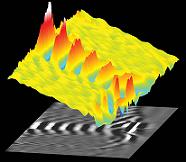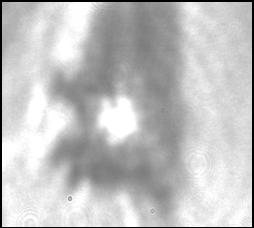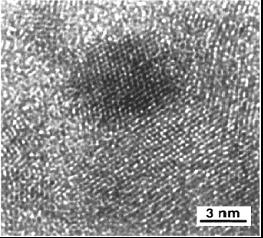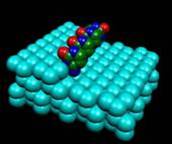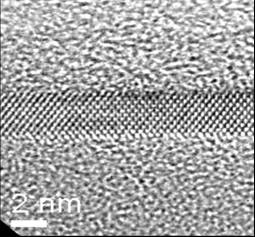
| Home | News | Events | Students & Postdocs | Publications | Presentations | Research Overview | Epi-Optic Lab | UT3 Laser Lab | Focht Fellowship |
| Femtosecond Spectroscopy Research Overview | |
|
A microscope objective lens (shown here) focuses a red (620 nm) femtosecond
laser pulse to a peak intensity of 3 X 1015 watts/cm2 in a cell containing 5 atm. Ar gas, producing an ionization spark (white
dot) which absorbs about 1% of the incident light. The remaining transmitted
light is spectrally shifted by ultrafast phase modulation at the ionization
front to a yellow-green color, which is clearly visible scattering from
the exit wall of the cell and the housing of the microscope objective.
Spectral analysis of this "blue-shifted" light has provided femtosecond-time-resolved
measurements of ionization dynamics at high light intensity (see W. M.
Wood et al., Phys. Rev. Lett. 67, 3523 (1991)). Recently
a more sensitive, sophisticated measurement of such frequency shifts--"femtosecond
longitudinal interferometry"--has provided femtosecond-time-resolved characterization
of density oscillations (Langmuir waves) of a fully-ionized helium plasma
in the wake of a very intense (3 X 1017 watts/cm2)
femtosecond laser pulse (C.
W. Siders et al., Phys.
Rev. Lett. 76, 3570 (1996)). Such "laser wakefield oscillations" are
promising media for charged particle acceleration (photograph by W. M.
Wood and G. Focht). |
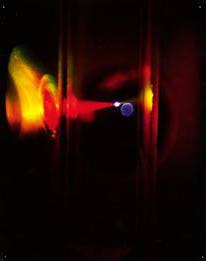 |
Our group uses ultrafast laser techniques for investigations in two
different areas: 1) the interaction of high intensity laser light with atoms, plasmas, and solid targets, and 2) to study kinetic processes and
defect structures at semiconductor interfaces. Thus our research includes
projects within the traditional categories of plasma, atomic and condensed
matter physics. |
|
Current Research Projects |
|
